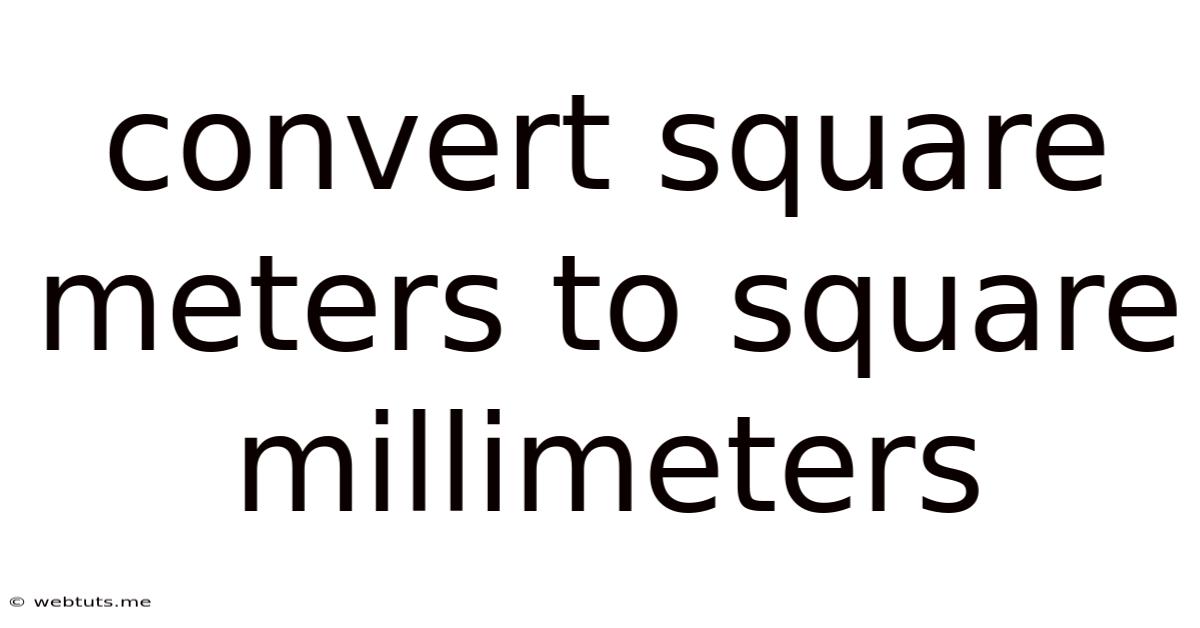Convert Square Meters To Square Millimeters
Webtuts
May 12, 2025 · 5 min read

Table of Contents
Converting Square Meters to Square Millimeters: A Comprehensive Guide
Converting units of area, such as square meters to square millimeters, might seem daunting at first, but with a clear understanding of the metric system and a simple formula, it becomes a straightforward process. This comprehensive guide will not only show you how to perform this conversion but also delve into the underlying principles, provide practical examples, and offer tips for avoiding common mistakes. We'll also explore the applications of this conversion in various fields.
Understanding the Metric System and Units of Area
The metric system, also known as the International System of Units (SI), is a decimal system based on powers of 10. This makes unit conversions relatively easy compared to other systems like the imperial system. The foundation of the metric system for area lies in its base unit of length: the meter (m).
Area is a measure of two-dimensional space. The standard unit for area in the metric system is the square meter (m²), which represents the area of a square with sides measuring one meter each. Other units of area, such as square millimeters (mm²), are derived from the meter using the system's decimal relationships.
The Relationship Between Meters and Millimeters
The key to converting square meters to square millimeters lies in the relationship between meters and millimeters:
- 1 meter (m) = 1000 millimeters (mm)
This means that one meter is equal to one thousand millimeters. This fundamental relationship is crucial for all area conversions within the metric system.
The Conversion Formula: Square Meters to Square Millimeters
To convert square meters to square millimeters, you need to consider the area's two-dimensional nature. Since 1 meter equals 1000 millimeters, a square meter contains 1000 x 1000 = 1,000,000 square millimeters.
Therefore, the conversion formula is:
Square Millimeters (mm²) = Square Meters (m²) x 1,000,000
This formula simply multiplies the number of square meters by one million to obtain the equivalent area in square millimeters.
Step-by-Step Conversion Process
Let's break down the conversion process with a clear, step-by-step example:
Example: Convert 2.5 square meters to square millimeters.
Step 1: Identify the value in square meters.
We have 2.5 m².
Step 2: Apply the conversion formula.
Square Millimeters = 2.5 m² x 1,000,000
Step 3: Perform the calculation.
Square Millimeters = 2,500,000 mm²
Therefore, 2.5 square meters is equal to 2,500,000 square millimeters.
Practical Applications of the Conversion
Converting square meters to square millimeters has numerous practical applications across various fields:
-
Engineering and Construction: Precise measurements are critical in these fields. Converting between square meters and square millimeters ensures accuracy in blueprint designs, material estimations, and construction projects involving smaller components. For example, calculating the area of tiny electronic components or microchips often necessitates this conversion.
-
Manufacturing and Production: Industries dealing with small-scale products, such as microelectronics or precision machining, frequently use square millimeters for area calculations. Converting from larger units like square meters ensures consistency and precision in manufacturing processes.
-
Scientific Research: In various scientific disciplines, including materials science and nanotechnology, measurements at the microscopic level are commonplace. Converting square meters to square millimeters allows scientists to work with consistent units of measurement.
-
Graphic Design and Printing: In graphic design and printing, the conversion is essential for ensuring accurate scaling and resolution when working with images and designs. Converting from larger units to smaller units helps maintain the quality of the final product.
-
Real Estate and Land Surveying: While square meters are commonly used for larger land areas, the conversion to square millimeters might become necessary when dealing with extremely precise land surveys or exceptionally small plots.
Avoiding Common Mistakes
While the conversion process is relatively simple, certain mistakes should be avoided:
-
Incorrect Formula: Ensure you use the correct formula: Square Millimeters (mm²) = Square Meters (m²) x 1,000,000. Using an incorrect multiplier will lead to an inaccurate result.
-
Unit Confusion: Always double-check the units involved. Confusing meters with millimeters or square meters with cubic meters will lead to significant errors.
-
Calculation Errors: Carefully perform the multiplication to avoid simple arithmetic mistakes. Using a calculator can help ensure accuracy.
-
Significant Figures: Pay attention to the number of significant figures in the original measurement to maintain accuracy in the converted value. Avoid adding unnecessary precision beyond what is justified by the initial measurement.
Advanced Conversions and Related Calculations
While the primary focus here is converting square meters to square millimeters, understanding the broader context of area conversions is beneficial. You can extend this knowledge to convert to other area units within the metric system, such as:
- Square centimeters (cm²): 1 m² = 10,000 cm²
- Square kilometers (km²): 1 km² = 1,000,000 m²
Furthermore, this knowledge forms a foundation for tackling more complex calculations involving volume (cubic meters, cubic millimeters, etc.) and other related geometric computations.
Conclusion: Mastering Square Meter to Square Millimeter Conversions
Converting square meters to square millimeters is a fundamental skill in various scientific, engineering, and practical applications. By understanding the metric system's decimal basis and applying the straightforward conversion formula (multiplying by 1,000,000), you can accurately perform this conversion with confidence. Remember to double-check your work, be mindful of units, and avoid common calculation errors to ensure accuracy in your results. Mastering this conversion empowers you to handle a wide range of area-related calculations with precision and efficiency. This skill is invaluable for accurate and reliable measurements across numerous fields.
Latest Posts
Related Post
Thank you for visiting our website which covers about Convert Square Meters To Square Millimeters . We hope the information provided has been useful to you. Feel free to contact us if you have any questions or need further assistance. See you next time and don't miss to bookmark.